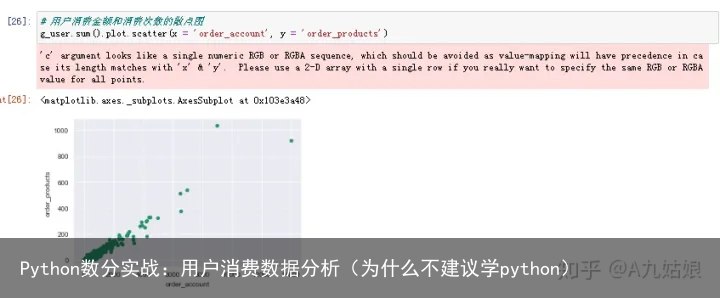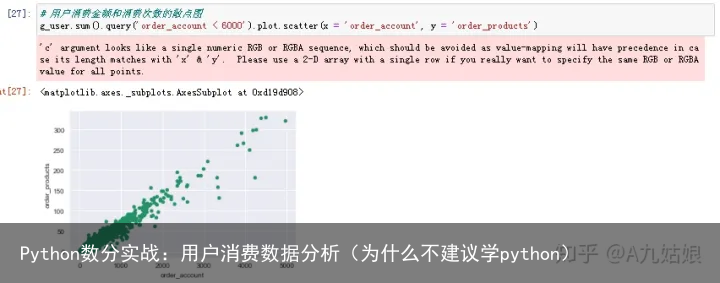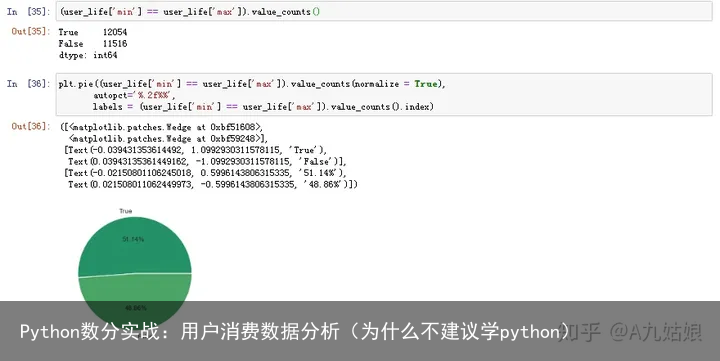新闻中心 
Python数分实战:用户消费数据分析(为什么不建议学python)
本次分析数据介绍:
数据为某奶茶店2018年1月-2019年6月的销售数据,共计69,659项数据,用户共计23,570名;
数据集共4个字段:
user_id: 用户idorder_id: 购买日期order_prodect: 购买产品数order_account: 购买金额明确问题(本次数据分析目的)
用户消费趋势分析(按月)用户个体消费分析用户消费行为分析用户复购率和回购率分析分析思路

理解数据
我们导入数据后简单看一下:
# 导入数据 df = pd.read_excel(MilkyTea_master.xlsx)
检查一下各字段类型:

数据清洗
本次抽样为全抽,不再进行选择子集;不再涉及列重命名;
1.数据类型转换
根据以上分析,我们需把用户id转化为字符串,把时间order_id转化为时间格式:
① 时间类型转换
# 时间类型转换,增加‘month’列 df[order_dt] = pd.to_datetime(df.order_dt,format=%Y%m%d) df[month] = df.order_dt.values.astype(datetime64[M])
② 字符串类型转换
df[user_id] = df[user_id].apply(lambda x : str(x))2.数据排序
# 按照“order_dt”排序 df = df.sort_values(by = order_dt,ascending =True)3.缺失值处理
我们检查是否存在缺失值:
for i in df.columns: print(df[i].isnull().value_counts())
无需进行缺失值处理;
4.异常值处理
检查描述统计信息,查看是否存在异常

以上,我们可以发现:
大部分订单只购买了少量商品(平均值2.41),有一定极值干扰;影虎的消费金额比较稳定(平均值35.89元,中位数25.98元),有一定极值干扰;最后,我们对index重新命名:
df = df.reset_index(drop = True)
构建模型
接下来,我们对问题进行分析:
1.用户消费趋势分析(按月)
我们按月度对用户进行分析,须将数据框按月分组:
g_month = df.groupby(month)1)每月消费金额
# 每月消费总金额 g_month.order_account.sum()2) 每月消费次数
# 每月消费总次数 g_month.user_id.count()3)每月购买数量
# 每月购买数量 g_month.order_products.sum()4)每月消费人数
# 每月消费人数 g_month.user_id.apply(lambda x : len(x.drop_duplicates()))以上我们也可用以下方式来统一分析:
df_table = df.pivot_table(index = month, values = [order_products,order_account,user_id], aggfunc = {order_products:sum, order_account:sum, user_id:count})
我们将分析结果进行数据可视化:
sns.set_palette(summer) sns.set_style(darkgrid) f = plt.figure(figsize = (20,16)) f.add_subplot(3,1,1) g_month.order_account.sum().plot() plt.title(order_account) f.add_subplot(3,1,2) g_month.order_products.sum().plot() plt.title(order_products) f.add_subplot(3,1,3) g_month.user_id.count().plot() plt.title(user_id)
2.用户个体消费
与按月分析不同,此次需要对数据库按用户id进行分组:
1)用户消费金额、消费次数的描述统计
# 按照用户进行分组 g_user = df.groupby(user_id) # 用户消费金额、消费次数的描述统计 g_user.sum().describe() 用户平均购买奶茶7杯,中位数为3杯,说明小部分的用户购买了大量的奶茶;用户平均消费106元,中位数43元,说明小部分用户购买大量的奶茶,存在极值干扰;
用户平均购买奶茶7杯,中位数为3杯,说明小部分的用户购买了大量的奶茶;用户平均消费106元,中位数43元,说明小部分用户购买大量的奶茶,存在极值干扰;2)用户消费金额和消费次数的散点图
# 用户消费金额和消费次数的散点图 g_user.sum().plot.scatter(x = order_account, y = order_products)
不是那么明显,我们选择购买金额<6000的数据集进行分析(去除极值):
# 用户消费金额和消费次数的散点图 g_user.sum().query(order_account < 6000).plot.scatter(x = order_account, y = order_products)
3)用户消费金额分布图
# 用户消费金额分布图 g_user.sum().order_account.plot.hist(bins = 20)
可知,用户消费金额大部分呈集中趋势,小部分异常值干扰了判断;
我们可以运用切比雪夫定理:‘所有数据中,至少有24/25(或96%)的数据位于平均数5个标准差范围内’,故,我们用7+16.98*5 ≈100 来排出异常值:
g_user.sum().query(order_account < 100).order_account.plot.hist(bins = 20)
4)用户累计消费占比(百分之多少的用户占百分之多少的销售额)
# 用户累计消费占比(百分之多少的用户占百分之多少的销售额) g_user.sum().sort_values(order_account).apply(lambda x : x.cumsum()/ x.sum()).reset_index().order_account.plot()
按用户消费金额升序排列,上图可知,60%的销售金额是被前5000名(近20%)的人贡献;而50%的用户仅贡献了15%的销售额;
3.用户消费行为分析
同样,我们依旧按用户分组进行分析:
1)用户第一次消费(首购)
# 用户第一次消费(首购) g_user.min().order_dt.value_counts().plot()用户首购分布:集中在前3月;在2月中旬期间,波动较剧烈;
2)用户最后一次消费
# 用户最后一次消费 g_user.max().order_dt.value_counts().plot()
用户最后一次购买时间分布较广,大部分最后一次购买集中在前3个月,说明可能存在很多用户购买了一次没有再复购;随着时间递增,最后一次购买的用户数量也在上升,消费呈流失上升状态;
3)新老客户消费比
① 多少用户仅消费1次
# 多少用户仅消费1次 user_life = g_user.order_dt.agg([min,max]) (user_life[min] == user_life[max]).value_counts() # 可视化(饼图) plt.pie((user_life[min] == user_life[max]).value_counts(normalize = True), autopct=%.2f%%, labels = (user_life[min] == user_life[max]).value_counts().index)
我们发现,超过一半用户仅消费一次;
② 每月新客占比
# 每月新客占比 g_user.min().month.value_counts() / g_month.user_id.apply(lambda x : len(x.drop_duplicates()))我们发现,首月消费新客占比100%,第二、三月逐渐新客数量占比减少,第四月后无新客;
4)用户分层
① RFM用户分层
这里需要补充一下RFM分析:
RFM是3个指标的缩写,最近一次消费时间间隔(Recency),消费频率(Frequency),消费金额(Monetary)。通过这3个指标对用户分类。最近一次消费时间间隔(R),上一次消费离得越近,也就是R的值越小,用户价值越高;消费频率(F),购买频率越高,也就是F的值越大,用户价值越高;消费金额(M),消费金额越高,也就是M的值越大,用户价值越高;所以,我们根据以上内容,对数据集根据order_products,order_account,order_dt进行数据透视:
# RFM用户分层 rfm = df.pivot_table(index = user_id, values = [order_products,order_account,order_dt], aggfunc= {order_products:sum, order_account:sum, order_dt:max})我们对最后一次消费时间计时间间隔,并对透视结果列重命名:
rfm[R] = (rfm.order_dt.max() - rfm.order_dt) / np.timedelta64(1,D) rfm.rename(columns={order_products:F,order_account:M},inplace = True)建立RFM模型:
def rfm_func(x): level = x.apply(lambda x:1 if x > 0 else 0) label = level.R +level.F + level.M d = { 111:重要价值客户, 011:重要保持客户, 101:重要发展客户, 001:重要挽留客户, 110:一般价值客户, 010:一般保持客户, 100:一般发展客户, 000:一般挽留客户 } result = d[label] return result rfm[label] = rfm[[R,F,M]].apply(lambda x : x - x.mean()).apply(rfm_func,axis=1)接着,我们对‘label’列分组求和:
rfm.groupby(label).sum()我们也可以分组后计数:
rfm.groupby(label).count()从RFM分层可知,大部分的用户是一般挽留客户,重要价值客户和重要保持客户合计约占20%;
我们进行可视化:
rfm.loc[rfm.label == 重要价值客户,color] = g rfm.loc[rfm.label != 重要价值客户,color] = r rfm.plot.scatter(F,R,c = rfm.color)② 用户生命周期-新、老、活跃、回流、流失
# 用户生命周期-新、老、活跃、回流、流失 pivoted_counts = df.pivot_table(index = user_id, columns= month, values= order_dt, aggfunc= count).fillna(0)需要对结果进行简化,如果购买次数大于0(大于等于1),有购买为1,无购买为0:
# 进行简化 df_purchase = pivoted_counts.applymap(lambda x : 1 if x>0 else 0)根据本月是否消费、前期是否消费、上月是否消费等多层维度,将用户划分为未注册、新注册、活跃、不活跃、回流、流失;
def active_statu(data): status = [] for i in range(18): # 当月未消费 if data[i] == 0: if len(status) > 0: if status[i-1] == unreg: status.append(unreg) else: status.append(unactive) else: status.append(unreg) # 当月有消费 else: if len(status) == 0: status.append(new) else: if status[i-1] == unactive: status.append(return) elif status[i-1] == unreg: status.append(new) else: status.append(active) return status purshase_stats = df_purchase.apply(active_statu,axis=1) purshase_stats = pd.DataFrame(purshase_stats)[0].apply(pd.Series) purshase_stats.columns = pivoted_counts.columns把‘unreg’用NAN替换,并对每月的用户状态进行统计:
purshase_stats_ct = purshase_stats.replace(unreg,np.NAN).apply(lambda x : pd.value_counts(x))# 转置 purshase_stats_ct.fillna(0).T可视化:
purshase_stats_ct.fillna(0).T.plot.area()可以逐行计算百分比:
# 可以逐行计算百分比 purshase_stats_ct.fillna(0).T.apply(lambda x : x/x.sum(),axis = 1) purshase_stats_ct.fillna(0).T.apply(lambda x : x/x.sum(),axis = 1).plot.area()5)用户购买周期(按订单)
① 用户订单周期
# 用户订单周期 order_diff = g_user.apply(lambda x: x.order_dt - x.order_dt.shift())查看描述统计:
② 用户订单分布
(order_diff/np.timedelta64(1,D)).hist(bins=20)订单周期呈指数分布用户平均购买周期是68天绝大部分用户购买周期都超过100天6)用户生命周期(按第一次&最后一次消费)
我们查看用生命周期(第一次&最后一次)描述统计:
(user_life[max] - user_life[min]).describe()((user_life[max] - user_life[min])/np.timedelta64(1,D)).hist(bins = 40)用户生命周期受只购买一次的用户影响较大用户平均消费时间差134天,中位数仅0天4.用户复购率和留存率
1)复购率
自然月内,购买多次的用户占比:
我们根据上述的对用户按月统计购买量pivoted_counts来分析:
如果当月购买了1次以上(大于1),则为1,存在复购;若购买了1次,为0;当月购买了0次,则为NAN;
purchase_r = pivoted_counts.applymap(lambda x : 1 if x > 1 else np.NAN if x == 0 else 0 )求和,为当月复购的人数;计数,为当月购买人数:
(purchase_r.sum() / purchase_r.count()).plot(figsize = (10,4))复购率稳定在20%左右,前三月因为有大量的新用户涌入,而这批用户只购买了一次,所以导致复购率低;
2)回购率(留存率)
曾经购买过的用户某一时间内再次购买的占比:
定义函数,如果当月购买,下月也购买为1;如果当月购买下月未购买,为0;如果当月未购买,则为NAN;
def purchase_back(data): status = [] for i in range(17): if data[i] ==1: if data[i+1] == 1 : status.append(1) if data[i+1] == 0 : status.append(0) else: status.append(np.NAN) status.append(np.NAN) return status purchase_b = df_purchase.apply(purchase_back,axis=1) purchase_b = pd.DataFrame(purchase_b)[0].apply(pd.Series) purchase_b.columns = pivoted_counts.columns回购率 = 次月再次购买/本月购买人数
(purchase_b.sum()/purchase_b.count()).plot(figsize = (10,4))分析结论
用户增长阶段仅在前三月,后期消费均为老客户;消费用户群体较为固定;超过50%的用户仅在前三月消费了一次,后期长期处于不活跃状态;用户消费呈流失上升状态;60%的销售金额是被前5000名(近20%)的人贡献。以上就是我们利用Python对用户消费情况、用户分层、用户生命周期及复购率、回购率简单的分析。








![[众诚云网科技]](/uploads/allimg/20190305/c4b08346cbe8b0efae6b132139c2d72a.png)
 2023-05-21
2023-05-21 浏览次数:次
浏览次数:次 返回列表
返回列表